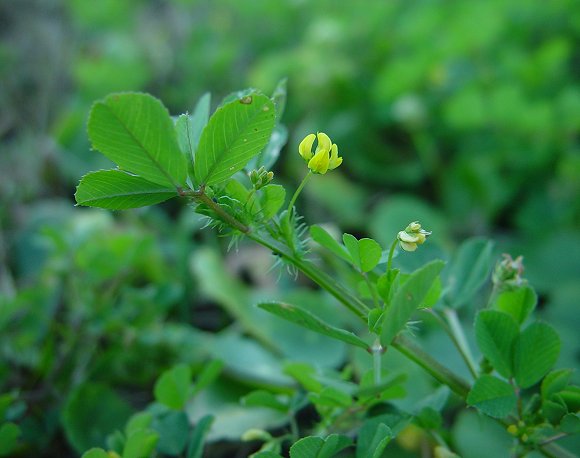Medicago polymorpha L.
California Bur Clover

Introduced
CC = *
CW = 3
MOC = 1
© DETenaglia
Medicago polymorpha L.California Bur Clover | |
 |
Introduced CC = * CW = 3 MOC = 1 |
© DETenaglia |
|
Family - Fabaceae/Faboideae Habit - Annual forb with shallow, slender taproots. Stems - Prostrate to loosely ascending from a spreading base, to 60 cm, often mat-forming or low mound-forming, glabrous. Leaves - Alternate, pinnately trifoliate, petiolate. Petioles 15-70 mm long. Stipules 3-15 mm long, the margins deeply few-lobed more than halfway to the midvein, fused to the petiole near the base. Leaflets 6-25 mm long, 4-20 mm wide, mostly longer than wide, obovate to obtriangular, rounded or minutely notched at the tip, usually with a small, narrowly triangular, sharply pointed tooth at the very tip, the surfaces glabrous or nearly so, lacking a red or purple spot.
Inflorescences - Appearing as small, headlike clusters, more or less globose, with 2-5 flowers, mostly shorter than the subtending leaves, the stalk 8-25 mm long. Flowers - Calyces with the tube 0.8-1.2 mm long, the lobes 1.5-2.0 mm long. Corollas 3.5-4.5 mm long, yellow. Filaments with the fused portion 1.5-2.0 mm long, the free portion 0.5-1.0 mm long.
Fruits - Modified legumes with the body 4-6 mm long, more or less globose, spirally coiled for mostly 2-4 turns, the outer margin thickened but lacking parallel ridges along the suture, usually with 2 rows of prickles, these 1.5-3.0 mm long, with hooked tips, otherwise glabrous, straw-colored to light brown at maturity, 3-6-seeded.
Flowering - April - May. Habitat - Waste places, lawns, roadsides, railroads. Origin - Native to Eurasia. Lookalikes - None close. Other info. - This introduced species is rare in Missouri. In the continental U.S. it is much more abundant along the Pacific and southern states. It is likely that the plant will spread over time. The species is easy to identify from its small yellow flowers, deeply fringed leaf stipules, and coiled fruits with bristly margins. Another species, M. arabica (L.) Huds., is similar but typically has a dark central splotch on each leaflet and stipules which are less deeply incised as those of M. polymorpha. Photographs taken in Crystal River, FL., 2-11-03 (DETenaglia). |